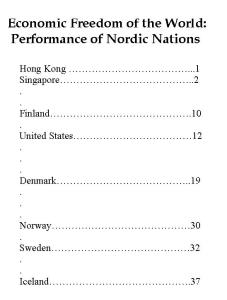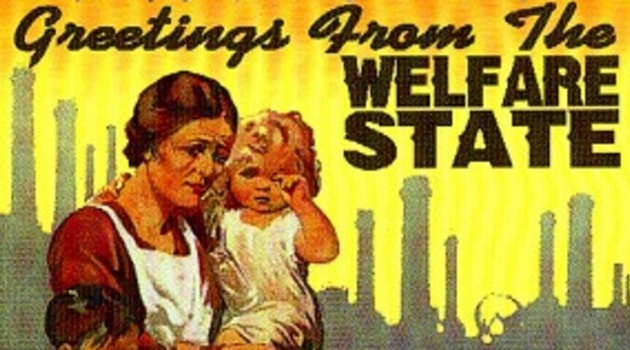In my younger years, I oftentimes would have arguments with statists who wanted me to believe that countries in Northern Europe like Sweden “proved” that generous welfare states were compatible with economic prosperity.
That doesn’t happen as often today because the Nordic nations in recent decades have not enjoyed rapid growth. Moreover, some of the nations – such as Sweden in the early 1990s and Iceland last decade – suffered from serious financial downturns.
So I stand by my position that free markets and small government are the recipe for prosperity.
That being said, there are still some interesting lessons to be learned from these countries.
As I’ve previously argued, the Nordic countries demonstrate that a big welfare state is “affordable”  so long as countries are willing to accept less growth and so long as they are willing to compensate for high taxes and high spending with very pro-market policies in other areas.
so long as countries are willing to accept less growth and so long as they are willing to compensate for high taxes and high spending with very pro-market policies in other areas.
And that’s definitely the case. If you examine the Economic Freedom of the World data, you see that Nordic nations get fairly decent scores because they have very laissez-faire policies for regulation, trade, monetary policy, and property rights.
Yes, the fiscal burden of the welfare state slows growth and drags down their rankings, but they still do far better than other European countries that have big governments and a lot of intervention. Just think of France (#58), Italy (#79), and Spain (#51).
With this bit of background, let’s now look at two new and interesting articles about the extent to which the Nordic nations should be role models.
Our first story is from the Washington Post, and it’s authored by a British journalist who lives in Denmark. He starts by noting the inordinate amount of praise these countries receive.
The United States is in the midst of an episode of chronic Scandimania, brought on in part by the habitually high placing of Sweden and its similarly prosperous, egalitarian, collectivist neighbors — Denmark, Norway, Iceland and Finland — in global rankings of everything from happiness to lack of corruption.
But he then points out that these is trouble in the Nordic paradise.
The Washington Post is not immune to Scandinavia’s charms, recently marveling at how Danish branches of McDonald’s manage to pay their employees 2.5 times U.S. McDonald’s workers’ wages (clue: When about 75 percent of earnings disappear as income and consumption taxes, higher wages are more necessity than choice). …and last month the Times assured us that “A Big Safety Net and Strong Job Market Can Coexist. Just Ask Scandinavia.” (*Cough* unemployment is 5.6 percent in the United States, vs. 8.1 percent in Sweden, 8.9 percent in Finland and 6.4 percent in Denmark.) …And global and domestic events are conspiring to make life a little more uncertain for these former high achievers. …the Scandinavian model’s structural fissures are coming under increasing stress. …the Norwegians seem to have lost their parsimonious, workaholic, Lutheran mojo. Norwegians treat Friday as a “free day” and take more sick leave than anyone else in Europe, if not the world — a law enshrines their right to claim sick days even while on holiday.
The author continues, pointing out some serious warts.
Sweden’s political establishment was subverting the democratic process. This has distracted from the slowing economy, increasing state and household debt levels, and one of the highest youth unemployment rates in Europe. …Denmark took a bigger hit than its neighbors following the 2008 global economic crisis, which increased pressure on its massive welfare state, funded by the highest taxes in the world. Household debt is the highest in Europe (any connection there, I wonder?). …along with the Norwegians they work among the fewest hours a year of any Europeans. …In Iceland, …ultra-Nordic social cohesion…led to the near-bankruptcy of the entire country.
And here are some more details that also don’t sound so encouraging.
These countries that do so well in life-satisfaction surveys also record the highest consumption of antidepressants in the world, and despite their reputation for gender equality, they have the highest rates of violence against women in Europe. …few Americans would truly embrace a Scandinavian-style society. The tax rates alone would likely be a sufficient deterrent. Though I’m a freelance journalist, I essentially work until Thursday lunchtime for the state. And it’s not as if the money that is left in my pocket goes all that far: These are fearfully expensive countries in which to live.
Here’s the bottom line from a balanced story.
Scandinavia is not the utopia that American liberals or the 11 million Americans of Nordic descent often make it out to be, just as it is not the quasi-commie, statist gulag that those on the right would often have us believe. …I’m not saying the Nordic miracle is over, but it was never a miracle. And it’s over.
Now let’s look at our second story, which was published by the New York Post.
The tone is more negative, but it basically has the same message.
In the American liberal compass, the needle is always pointing to places like Denmark. Everything they most fervently hope for here has already happened there.
But there’s bad news in the land of the Northern Lights.
Here’s what he writes about Denmark.
Visitors say Danes are joyless to be around. Denmark suffers from high rates of alcoholism. In its use of antidepressants it ranks fourth in the world. (Its fellow Nordics the Icelanders are in front by a wide margin.) Some 5 percent of Danish men have had sex with an animal. Denmark’s productivity is in decline, its workers put in only 28 hours a week, and everybody you meet seems to have a government job. …Danes operate on caveman principles — if you find it, share it, or be shunned. Once your date with Daisy the Sheep is over, you’d better make sure your friends get a turn.
Though Daisy is lucky that she’s not on the tax rolls. The tax system in that nation is so oppressive that I’ve joked birthers should accuse Obama of having been born in Denmark.
In addition to paying enormous taxes — the total bill is 58 percent to 72 percent of income — Danes have to pay more for just about everything. Books are a luxury item. Their equivalent of the George Washington Bridge costs $45 to cross. …Health care is free — which means you pay in time instead of money. Services are distributed only after endless stays in waiting rooms. (The author brought his son to an E.R. complaining of a foreign substance that had temporarily blinded him in one eye and was turned away, told he had to make an appointment.) Pharmacies are a state-run monopoly, which means getting an aspirin is like a trip to the DMV.
But the author doesn’t just pick on Denmark.
Iceland’s famous economic boom turned out to be one of history’s most notorious real estate bubbles. …The success of the Norwegians — the Beverly Hillbillies of Europe — can’t be imitated. Previously a peasant nation, the country now has more wealth than it can spend: Colossal offshore oil deposits spawned a sovereign wealth fund that pays for everything. Finland, which tops the charts in many surveys (they’re the least corrupt people on Earth, its per-capita income is the highest in Western Europe and Helsinki often tops polls of the best cities), is also a leader in categories like alcoholism, murder (highest rate in Western Europe), suicide and antidepressant usage. …Booze-related disease is the leading cause of death for Finnish men, and second for women. …“Dark” doesn’t just describe winter in the Arctic suburbs, it applies to the Finnish character.
Sweden gets a lot of attention.
Immigration is associated in the Swedish mind with welfare (housing projects full of people on the dole) and with high crime rates (these newcomers being more than four times as likely to commit murder). Islamist gangs control some of the housing projects. Friction between “ethnic Swedes” and the immigrants is growing. Welfare states work best among a homogeneous people, and the kind of diversity and mistrust we have between groups in America means we could never reach a broad consensus on Nordic levels of social spending. Anyway, Sweden thought better of liberal economics too: When its welfare state became unsustainable (something savvy Danes are just starting to say), it went on a privatization spree and cut government spending from 67 percent of GDP to less than half.
And then there’s this excerpt about the Swedes, which makes me think it might be better to cohabit with a sheep in Copenhagen.
…a poll in which Swedes were asked to describe themselves, the adjectives that led the pack were “envious, stiff, industrious, nature-loving, quiet, honest, dishonest and xenophobic.” In last place were these words: “masculine,” “sexy” and “artistic.”
And here’s his conclusion.
Scandinavia, as a wag in The Economist once put it, is a great place to be born — but only if you are average. …That’s Scandinavia for you, folks: Bland, wholesome, individual-erasing mush. But, hey, at least we’re all united in being slowly digested by the system.
Indeed, the Nordic focus on equality is so pervasive that it leads to unbelievably stupid policies.
P.S. The single-most compelling piece of evidence about the superiority of the American system is that Swedes in America earn far more than Swedes in Sweden.
P.P.S. The second-most compelling piece of evidence about the limits of Nordic statism is that these nations became prosperous before big welfare state were imposed. I call this the paradox of Wagner’s Law.

